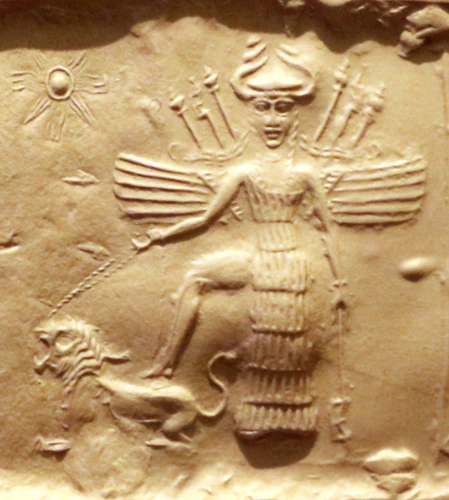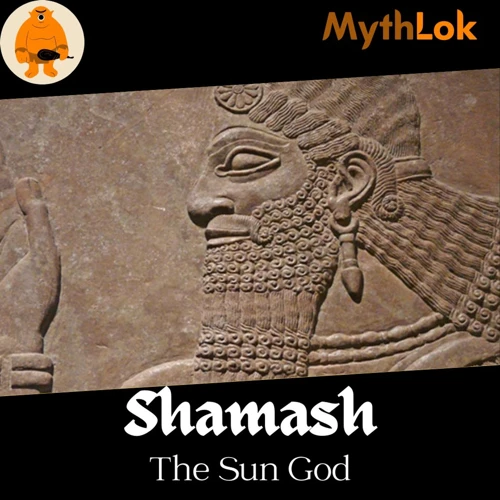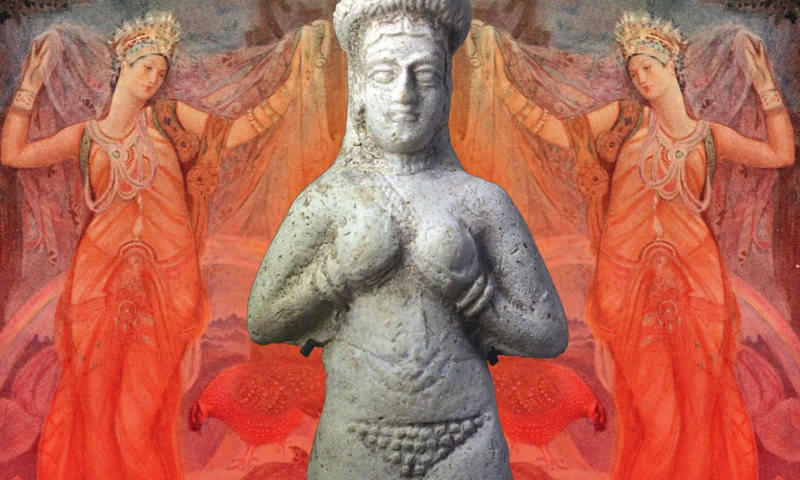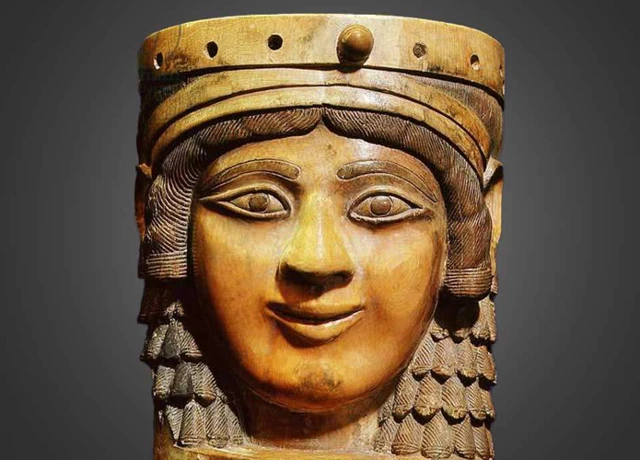Ishtar, the Goddess of Love and War, holds a prominent place in the realm of Mesopotamian mythology. This enigmatic deity has captivated the ancient minds with her dual nature, embodying both the aspects of love and war. From her origins in Sumerian and Akkadian mythology to her iconic symbols and mythological stories, Ishtar’s influence and worship have left an indelible mark on the ancient Mesopotamian civilization. Join us on a journey to unravel the complexities surrounding Ishtar and discover the rich tapestry of myth and worship that surrounds this powerful goddess.
The Origins of Ishtar

Ishtar, known as Inanna in Sumerian mythology, has deep roots in the ancient Mesopotamian pantheon. She emerged as a prominent deity in both Sumerian and Akkadian myths, showcasing her enduring influence in the region. In Sumerian mythology, Inanna was revered as the goddess of love, beauty, fertility, and warfare. She was considered the daughter of the moon god, Nanna, and the sister of the sun god, Utu. In Akkadian mythology, Inanna became known as Ishtar, maintaining her position as a goddess of love and war. In both civilizations, Ishtar’s cult and worship flourished, making her one of the most revered goddesses of the time. Ishtar’s origins can be traced back to the ancient creation myths, such as the Enuma Elish, where she played a vital role in the birth of the universe. Her connections to the underworld and fertility were explored in other stories, such as the myth of Ereshkigal and Nergal. Throughout her evolution, Ishtar remained a complex and multifaceted deity, intertwined with the rich tapestry of Mesopotamian mythology.
1. Ishtar in Sumerian Mythology
In Sumerian mythology, Ishtar, known as Inanna, occupied a prominent position as one of the most revered goddesses. She embodied various aspects of life, including love, beauty, fertility, and war. As the daughter of Nanna, the moon god, and the sister of Utu, the sun god, Ishtar held immense power and influence. She was often depicted as a youthful and vibrant goddess, radiating beauty and sensuality. Ishtar’s role in Sumerian mythology extended beyond her associations with love and romance. She was also linked to the fertility of the land and the protection of agriculture, ensuring bountiful harvests for the people. Ishtar’s presence in Sumerian myths can be seen in her involvement in the creation myth Enuma Elish, where she played a crucial role in the birth of the universe. Additionally, her journey to the underworld, as described in the myth of Ereshkigal and Nergal, showcased her power over life and death. Ishtar’s significance in Sumerian mythology highlights the complex nature of this deity and the integral role she played in the beliefs and rituals of the ancient Mesopotamian civilization.
2. Ishtar in Akkadian Mythology
In Akkadian mythology, Ishtar maintained her prominent position as the goddess of love and war, adopting many similarities from her Sumerian counterpart, Inanna. She was considered the daughter of the moon god, Sin, and her divine siblings included the sun god, Shamash, and the underworld god, Nergal. Ishtar’s role in Akkadian mythology expanded beyond her association with love and warfare. She was also revered as the goddess of fertility, beauty, and sexuality. Ishtar was believed to have control over the natural world, bringing abundance and prosperity to the land. Her influence extended to the realms of justice, politics, and divine order. Ishtar’s connection to the underworld was exemplified in the myth of Ereshkigal and Nergal, where she descended to the realm of the dead in her pursuit of power. This myth reinforced Ishtar’s dual nature as both a compassionate and vengeful deity. In Akkadian art and poetry, Ishtar was often depicted as a radiant and alluring figure, symbolizing her association with love and beauty. Ishtar’s presence in Akkadian mythology solidified her as a complex and influential goddess, captivating the hearts and minds of the ancient Mesopotamians.
References:
– Exploring the Underworld in Mesopotamian Myth: Ereshkigal and Nergal. Available at: /exploring-underworld-mesopotamian-myth-ereshkigal-nergal/
The Dual Nature of Ishtar

The dual nature of Ishtar, as the Goddess of Love and War, is a central aspect of her mythology. Ishtar embodies the paradoxical combination of passion, desire, and fertility associated with love, as well as the fierce strength, aggression, and strategic prowess of a warrior. In her role as the Goddess of Love, Ishtar represents the romantic and sensual aspects of human relationships. She is often associated with sexuality, beauty, and desire. Ishtar’s influence extends to matters of fertility, where she was invoked by individuals seeking to conceive or ensure bountiful crops. As the Goddess of War, Ishtar demonstrates her ferocity and capabilities as a warrior. She is often depicted as leading armies into battle, protecting her followers, and vanquishing enemies. Ishtar’s dual nature encompasses the power and intensity of both love and war, forming a complex character that captivated the ancient Mesopotamian mindset. Throughout her myths and legends, Ishtar’s duality is exemplified, showcasing her ability to navigate and excel in both realms.
1. Ishtar as the Goddess of Love
Ishtar, the Goddess of Love, occupies a central role in Mesopotamian mythology, showcasing her divine influence in matters of the heart and beauty. As the goddess of love, Ishtar was associated with passion, desire, and fertility. She was both a source of romantic love between mortals and a bringer of divine love and blessings. In Sumerian mythology, Ishtar’s love and beauty were celebrated in numerous hymns and poems, praising her irresistible allure and captivating charm. She was believed to bestow blessings on couples, ensuring their fertility and harmonious relationships. Ishtar’s association with love extended beyond mortal beings. She was also revered as a goddess who influenced the relationships of gods and goddesses within the pantheon. Her love affairs with both mortal men and gods were often the subject of mythological tales, showcasing her passionate and sometimes tempestuous nature. Ishtar’s role as the Goddess of Love further enhanced her status as a cherished deity in the eyes of the ancient Mesopotamians. Her influence over matters of the heart continues to captivate and inspire individuals to this day, demonstrating the enduring power of love and the goddess who personified it.
2. Ishtar as the Goddess of War
Ishtar’s role as the Goddess of War was as significant as her role as the Goddess of Love. In Mesopotamian mythology, she embodied the fierce and destructive aspects of warfare. Ishtar was often depicted armed with divine weaponry, ready to unleash her fury upon her enemies. She was called upon by kings and warriors for protection and victory in battle. In her warrior form, Ishtar was associated with the storm and thunder, symbolizing her power to strike fear into the hearts of her foes. She was also believed to have the ability to control and conquer the forces of nature, making her an even more formidable figure on the battlefield. Ishtar’s role as a warrior goddess was not only limited to physical combat but also extended to psychological warfare and manipulation. She was known to sow discord among enemies and could even incite conflicts between nations. Ishtar’s association with war showcased her prowess as a goddess who could bring both victory and chaos. To honor her as a goddess of war, temples and cults dedicated to Ishtar included rituals and offerings specifically aimed at seeking her protection and favor on the battlefield. The worship of Ishtar as a warrior goddess served as a reminder of the complexities and paradoxes within human existence and the need for divine intervention in times of conflict.
Ishtar’s Iconography and Symbols
![]()
Ishtar’s iconography and symbols are representative of her power and the domains she presides over. One of the most prominent symbols associated with Ishtar is the Eight-Pointed Star. This star, known as the Ishtar Star or Star of Ishtar, represents the planet Venus, the celestial body associated with the goddess. The star is often depicted within various artistic representations of Ishtar, highlighting her connection to love and beauty. Another significant symbol associated with Ishtar is the lion and the bull. Ishtar is often depicted accompanied by lions, symbolizing her fierce and protective nature. The bull, on the other hand, represents her association with war and strength. Ishtar’s divine weaponry is another important aspect of her iconography. She is often depicted holding a bow and arrows, signifying her prowess as a warrior goddess. Some depictions also show her with an axe or a mace, emphasizing her role in battle. These symbols collectively embody Ishtar’s multifaceted nature, showcasing her as a powerful goddess of love and war. It is through these symbols that devotees and followers of Ishtar could recognize and honor her presence in their lives, seeking her protection, guidance, and blessings.
1. The Eight-Pointed Star
The Eight-Pointed Star holds a significant place in the iconography of Ishtar. This symbol, also known as the Star of Ishtar, represents the goddess herself and her various attributes. Each point of the star is said to represent a different aspect of Ishtar’s power and influence. The eight points can symbolize her dominion over the heavens, the earth, and the underworld, making her a deity of immense cosmic significance. The Eight-Pointed Star is often depicted on Ishtar’s temples, statues, and sacred artifacts, showcasing her connection to the divine realm. This symbol is also associated with Ishtar’s role as a goddess of love and fertility, as the eight points can represent the cyclical nature of life and the seasons. The prominence of the Eight-Pointed Star in Ishtar’s iconography suggests her cosmic authority and enduring presence in Mesopotamian mythology. To explore Ishtar’s connection to the creation myth, you can read more about the Enuma Elish in our article on the creation myth of Mesopotamian gods.
2. The Lion and the Bull
Ishtar’s iconography is rich with symbols that represent her power and influence. Among the most significant symbols associated with Ishtar are the lion and the bull. These animals embody strength, power, and ferocity, qualities attributed to Ishtar as the goddess of war. In Mesopotamian art and religious iconography, Ishtar is often depicted standing on the backs of these animals or in close proximity to them. The lion represents her authority and dominion over the animal kingdom, while the bull symbolizes her association with fertility and abundance. The lion and the bull also have deeper mythological connections. The bull is often linked to Ishtar’s counterpart, the god Dumuzid, who is depicted as a bull in certain myths. The lion, on the other hand, is associated with Ninhursag, the mother goddess of Mesopotamian mythology. These connections highlight the interconnectedness of the deities within the pantheon and emphasize Ishtar’s intricate role in the divine order.
3. The Divine Weaponry
Ishtar, the Goddess of Love and War, is often associated with divine weaponry in Mesopotamian mythology. As a powerful and assertive deity, Ishtar wields weapons that symbolize her authority and prowess in both love and war. One notable divine weapon associated with Ishtar is the bow and arrow. The bow represents her skill as a formidable warrior, capable of striking down her enemies with precision and strength. Ishtar’s arrows, often depicted as flaming projectiles, embody her destructive power and the ability to bring chaos to her foes. In addition to the bow and arrow, Ishtar is also associated with the mace, a heavy weapon used for close combat. The mace symbolizes her strength and ability to crush her adversaries. Ishtar’s divine weaponry showcases her prowess as a goddess of war, with the ability to defend her devotees and assert her dominance on the battlefield. This aspect of Ishtar’s iconography further reinforces her dual nature, where she can be both a loving and protective deity, as well as a formidable warrior.
Ishtar’s Mythological Stories

Ishtar’s mythological stories provide fascinating insights into her character and the role she played in the Mesopotamian pantheon. One of the most well-known stories is “The Descent of Ishtar.” In this myth, Ishtar descends into the underworld, defying the rules of the kingdom of Ereshkigal. Along her journey, Ishtar faces a series of trials and obstacles, symbolizing the challenges faced by humanity. This story highlights Ishtar’s fierce determination and her power to overcome adversity. Another significant myth involving Ishtar is the tale of Ishtar and Tammuz. Tammuz, a vegetation god, represents the cycle of life and death. According to the myth, Ishtar mourns Tammuz’s death in the underworld, causing the earth to wither. This myth symbolizes the annual cycle of death and rebirth in nature and emphasizes Ishtar’s connection to fertility and the cycles of life. Ishtar’s mythological stories demonstrate her complex nature as a goddess of both love and war, as well as her profound influence on the ancient Mesopotamian culture.
1. The Descent of Ishtar
The Descent of Ishtar is a captivating myth that recounts Ishtar’s journey to the underworld. In this tale, Ishtar decides to descend into the realm of her sister, Ereshkigal, who is the queen of the underworld. Ishtar’s intention is to conquer the realm and establish her dominance over death. However, her descent is filled with peril and challenges. As Ishtar approaches the gates of the underworld, she encounters seven gates, and at each gate, she is required to remove a piece of her divine clothing or jewelry. By the time she reaches Ereshkigal’s throne, she stands before her sister completely vulnerable and stripped of her divine essence. Ereshkigal, filled with resentment, unleashes a series of punishments on Ishtar. She imprisons her, inflicts diseases upon her, and even kills her. The world above mourns the absence of Ishtar, and without her presence, everything becomes desolate and devoid of love and fertility. Eventually, Ishtar is resurrected and returns to the surface, regaining her divine power and restoring the world to its former vibrant state. This myth serves as a powerful metaphor, symbolizing the cycle of life, death, and rebirth, as well as the connection between the realm of the living and the realm of the dead. The Descent of Ishtar showcases Ishtar’s resilience, her ability to overcome challenges, and her role as a mediator between life and death.
2. Ishtar and Tammuz
Ishtar’s mythological stories encompass a diverse range of tales, one of which involves her relationship with Tammuz. Tammuz, also known as Dumuzid, was a shepherd and a lover figure in Mesopotamian mythology. He was associated with fertility and vegetation, and his relationship with Ishtar symbolized the cycle of life, death, and rebirth. In the myth, Ishtar descended into the Underworld to save Tammuz after his death. However, during her absence, the world suffered from a lack of fertility and growth. Ishtar’s journey to the Underworld to retrieve Tammuz represented the changing of the seasons, wherein his return would bring about rejuvenation and abundance. This myth serves as a symbolic representation of the important connection between Ishtar’s role as a goddess of love, fertility, and the cycles of life. The story of Ishtar and Tammuz echoes the universal theme of death and rebirth, emphasizing the eternal renewal of life in Mesopotamian mythology. (Source: Ninhursag: The Mother Goddess in Mesopotamian Mythology)
Ishtar’s Influence and Worship
Ishtar’s influence and worship were far-reaching in the ancient Mesopotamian civilization. As the goddess of love and war, Ishtar held immense power and significance in the lives of the people. Her worship was not confined to a particular city or region, as her popularity spread across various city-states in Mesopotamia. Ishtar’s influence extended beyond mythology, permeating aspects of daily life, religion, and even politics.
1. Ishtar in the Mesopotamian Pantheon: Ishtar occupied a central position within the pantheon of Mesopotamian gods. She was often considered as one of the supreme deities, alongside gods like Anu, Enlil, and Ea. Ishtar’s association with love and fertility made her a vital figure in matters of procreation and the continuation of life. Her presence was invoked during rituals and ceremonies related to love, marriage, and childbirth.
2. Temples and Cults Dedicated to Ishtar: Ishtar’s worship was widely observed in various temples and cults throughout Mesopotamia. The most prominent temple dedicated to her was the Esagila in Babylon, where Ishtar had a significant presence and where her statue was revered. Additionally, other major cities, such as Uruk and Nineveh, also had dedicated temples for Ishtar. These places of worship served as centers for religious activities and attracted pilgrims from far and wide.
3. Rituals and Offerings: The worship of Ishtar involved elaborate rituals and ceremonies. Priests and priestesses served as mediators between the people and the goddess, performing rituals to seek her blessings and favor. Offerings of food, drink, and incense were presented to Ishtar as a way of showing devotion and seeking her protection. It was believed that offerings made to Ishtar could ensure prosperity, fertility, and protection from enemies.
4. Sacred Prostitutes: One unique aspect of Ishtar’s worship was the presence of sacred prostitutes, known as the “qadishtu” or “hierodule.” These women served as representatives of the goddess and engaged in sexual acts as a form of religious devotion. The practice was seen as a way to honor Ishtar’s role as the goddess of love and fertility and to ensure her blessings for the community.
Ishtar’s influence and worship were deeply ingrained in the social, cultural, and religious fabric of ancient Mesopotamia. Her multifaceted nature as the goddess of love and war made her an integral part of the daily lives and aspirations of the people, leaving an enduring legacy that reverberated throughout history.
1. Ishtar in the Mesopotamian Pantheon
Ishtar held a significant position within the Mesopotamian pantheon, where she was revered alongside other important deities. In Sumerian mythology, she was regarded as one of the most powerful goddesses, occupying a central role in the hierarchy of gods and goddesses. She was often depicted as the daughter of the moon god, Nanna, and was closely associated with other major deities like Utu (the sun god) and Enki (the god of wisdom). Ishtar’s influence extended beyond love and war, as she was also linked to fertility, agriculture, and even the governance of the cosmos. Her role as a protectress of cities emphasized her importance in the Mesopotamian society, and she was believed to have the power to bring prosperity and protection to her worshippers. Ishtar’s influence can also be observed in the Akkadian pantheon, where she was considered as the queen of all the gods. Despite variations in the stories and beliefs associated with her, Ishtar held a central position in the Mesopotamian pantheon and was revered throughout the region.
2. Temples and Cults Dedicated to Ishtar
Temples and cults dedicated to Ishtar were numerous and widespread throughout ancient Mesopotamia, indicating the immense influence she held over the people. One notable temple was the Eanna temple in Uruk, dedicated to Inanna in Sumerian mythology and Ishtar in Akkadian mythology. This temple was a grand structure, believed to be the earthly residence of Ishtar herself. Another significant temple was the Ishtar Gate in Babylon, which served as a grand entrance to the city and showcased the power and prestige associated with the goddess. In addition to these major temples, smaller shrines and cult centers dedicated to Ishtar were scattered across the region. These local centers of worship provided a place for devotees to honor and offer sacrifices to the goddess. Ishtar’s cults were known for their rituals and ceremonies, often involving music, dance, and offerings of food and drink. The priests and priestesses who served Ishtar played a vital role in these cults, performing sacred rites and acting as intermediaries between the mortal world and the realm of the divine. The worship of Ishtar was deeply ingrained in the social fabric of Mesopotamian society, reflecting the important role she played in the lives of the people.
Conclusion
In conclusion, Ishtar, the Goddess of Love and War, holds a significant place in Mesopotamian mythology. Her origins can be traced back to the Sumerian and Akkadian civilizations, where she was revered for her dual nature. Ishtar represented both love and war, embodying the complexities of human emotions and the cycles of life. Through her mythological stories, such as the Descent of Ishtar and her connection with Tammuz, Ishtar left a lasting impact on the Mesopotamian culture. The symbols associated with Ishtar, such as the eight-pointed star, the lion, and the bull, further exemplify her divine power and influence. Ishtar’s worship and cults were widespread throughout Mesopotamia, with numerous temples dedicated to her veneration. Her presence in the pantheon of gods showcased the importance of love and war in the ancient Mesopotamian society. Overall, Ishtar’s legacy is a testament to the enduring fascination with the divine balance between love and war in human existence.
Frequently Asked Questions
1. Who is Ishtar?
Ishtar is a goddess in Mesopotamian mythology, known for her dual nature as the goddess of love and war. She held a prominent role in Sumerian and Akkadian mythologies, captivating the ancient minds with her complex character.
2. What are Ishtar’s origins?
Ishtar, originally known as Inanna in Sumerian mythology, emerged as a prominent deity in ancient Mesopotamia. She later became known as Ishtar in Akkadian mythology, while retaining her position as the goddess of love and war.
3. What is the significance of Ishtar’s dual nature?
Ishtar’s dual nature as the goddess of love and war represents the two essential aspects of human existence. She embodies both the power to nurture and bring forth life as well as the strength and ferocity needed to protect and defend.
4. What are Ishtar’s symbols?
Ishtar is often associated with symbols such as the eight-pointed star, representing the planet Venus and her connection to love and beauty. Additionally, she is symbolized by the lion and the bull, animals associated with power and fertility.
5. What are the main mythological stories involving Ishtar?
Two renowned mythological stories featuring Ishtar include the “Descent of Ishtar” and the tale of Ishtar and Tammuz. These stories delve into her journeys to the underworld and explore themes of love, death, and rebirth.
6. How was Ishtar worshiped in ancient Mesopotamia?
Ishtar was worshipped through the dedication of temples and cults across Mesopotamia. Her followers sought her blessings for matters concerning love, fertility, and protection in times of war.
7. Was Ishtar part of a larger pantheon?
Yes, Ishtar was part of the larger Mesopotamian pantheon. She had connections and relationships with other prominent gods and goddesses, such as Anu, Enlil, and Ninhursag.
8. Is there a connection between Ishtar and creation myths?
Yes, Ishtar is often associated with creation myths in Mesopotamian mythology. She played a vital role in the birth of the universe, as depicted in the Enuma Elish, one of the ancient creation myths.
9. Are there any historical sites or artifacts dedicated to Ishtar?
Archaeological evidence has unearthed various temples and artifacts dedicated to the worship of Ishtar. One notable example is the Temple of Ishtar in the ancient city of Uruk (modern-day Iraq).
10. How does Ishtar’s legacy continue today?
While Ishtar’s worship has ceased over time, her legacy endures through her representation in ancient texts, artworks, and artifacts. She continues to fascinate and inspire those interested in Mesopotamian mythology and the study of ancient civilizations.








